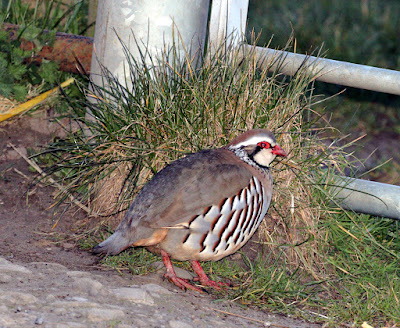Almost three weeks of cold easterly winds has meant not much ringing. There have been a few migrants arriving but not in any great numbers. Until today I had seen a single Swallow and just two House Martins, the latter back on territory at the big house on the corner on 12th April.
Saturday morning and the dashboard read 1°C as I set off birding in winter woollies.
There was a fine start at Pilling by way of a couple of rarities followed by the customary Barn Owl. At Lane Ends, Pilling I watched a couple of Little Egrets on the marsh just as a larger egret flew east towards Cockerham. Something made me lift my bins to look closer at the Grey Heron sized bird, upon which it turned out be a Great White Egret – same jizz, same size as a grey, but definitely all over white and with a large yellow bill. Four Swallows flew east as both Chiffchaff and Willow Warbler sang from the trees.
Great White Egret
Not far away a pair of Grey Partridge fed in a weedy field where the mild winter has produced a second crop of oilseed rape. As noted here on the blog many times, the Grey Partridge is now exceedingly uncommon in this part of Lancashire, so scarce that it is difficult to see how even with environmental schemes designed to help the species can ever reach its former status as a common farmland bird.
Grey Partridge
Compare the sad state of out native partridge with the introduced and now ubiquitous Red-legged Partridge. This is now the common partridge of the UK courtesy of the shooting fraternity who release many millions into the countryside each winter for “sport”. The birds left from the winter slaughter go on to breed in the same countryside that is now devoid of our native partridge and many other farmland birds. Such is the topsy-turvy way that we in the UK are governed by hopeless politicians and disinterested administrators whose loyalties are given to anyone but the people who pay their wages.
Red-legged Partridge
The Barn Owl, a poster boy for Wyre Council, was one of two I saw this morning, the other around Jeremy Lane when on the way to Cockersands.
Barn Owl
Barn Owl
At Braides Farm there was a Merlin, a single Wheatear, 8 Linnet, 4 Pied Wagtails, 1 Little Egret, and three more Swallows flying into the easterly breeze.
At Conder Green the principal species at the moment is Oystercatcher and where just as a week ago I counted 50+, most of them still in the throes of sorting out their forthcoming family life. If these numbers stay the same we should end up with 10-12 pairs breeding on habitat now highly suitable to their requirements. No Avocets today, or at least none in sight or heard, so perhaps the dozen or more individuals seen this year have all gone elsewhere. Otherwise - 12 Greylag, 4 Canada Geese, 12 Shelduck, 8 Tufted Duck and 2 Little Egret. No Swallows, Sand Martins or House Martins seen but there was 1 Willow Warbler in brief song.
Oystercatcher
A drive up to Cockersands proved uneventful apart from a single but elusive Barn Owl that twice escaped closer inspection as it hunted a wide expanse of fields. Barn Owls are pretty easy to see just now if you know where to look. I suspect that a good number of hunting birds are feeding young, their sitting partner, or both.
I found a lonely Swallow on the way to Cockersands. A single bird was sat above a traditional farm’s doorway, waiting for someone to open the door. The poor thing had not long arrived from scorching Africa to a familiar UK greeting of cold easterly winds and daytime temperatures of less than 10° C.
Swallow
There was a lovely flock of about 800 Golden Plovers on the fields at Cockersands. A flock has been thereabouts all through winter but it is only now that many begin to show their black and gold-spangled plumage. The Golden Plover is a truly beautiful bird that unbelievably, in 2019 and for the foreseeable future, can be legally shot in this country and many others.
Golden Plover
It is very difficult to get photographs of our Golden Plovers, hunted as they are throughout Northern Europe by homo sapiens.
I watched as the flock spread out across two large fields, feeding as they went, stopping occasionally to crouch in unison as an unseen threat emerged. Their spangled plumage serves them well, even in the winter when they might become the target of an overhead Peregrine.
Gradually, after a minute or more and when the coast was clear, they would stand one by one, two by two, and then continue feeding at a walking pace until all were at 80 yards or so from the field edge. And then soon after, at some unknown signal or perhaps when they sensed they were too close to the road where people and vehicles pass by, they would rise and fly as one back to the far edge of the field 400 yards away. Very quickly they started again their slow crossing of the field in search of food.
Although the forecast is for yet another week of cold, easterly winds, back soon with more news.
Linking today to Anni's Birding and Eileen's Blogspot.
Linking today to Anni's Birding and Eileen's Blogspot.








